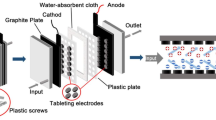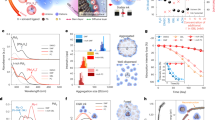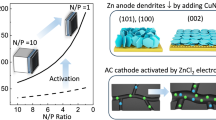Abstract
Traditional capacitive deionization (CDI) materials usually exhibit low salt adsorption capacities due to the limitations in optimizing their specific surface area and chemical composition. Here we introduced the curvature parameter as a new variable for designing high-performance CDI electrodes. On the basis of a comprehensive surface curvature/electric field model, we found that smaller surface curvature radii may result in higher-concentration ion distributions. As a typical experimental example, bicontinuous mesoporous polypyrrole with saddle-shaped high-curvature surfaces demonstrated an enhanced ion docking effect, which provided high salt adsorption capacity values of 262.7 mg g−1 at 1.2 V and 312.5 mg g−1 at 100 mA g−1, along with an ultra-long cycling life of over 2,000 cycles. This CDI performance surpassed those of all previously reported CDI electrodes. This study provides a new design paradigm based on curvature structural engineering for next-generation CDI materials and demonstrates a promising approach for developing large-scale and sustainable high-performance CDI devices.
This is a preview of subscription content, access via your institution
Access options
Subscribe to this journal
Receive 12 digital issues and online access to articles
$119.00 per year
only $9.92 per issue
Buy this article
- Purchase on SpringerLink
- Instant access to full article PDF
Prices may be subject to local taxes which are calculated during checkout





Similar content being viewed by others
Data availability
All relevant data that support the results of this study are presented in the main text and Supplementary Information. Source data are provided with this paper.
References
He, C. et al. Future global urban water scarcity and potential solutions. Nat. Commun. 12, 4667 (2021).
Ou, R. et al. A sunlight-responsive metal–organic framework system for sustainable water desalination. Nat. Sustain. 3, 1052–1058 (2020).
Chen, H. et al. Ultrahigh-water-flux desalination on graphdiyne membranes. Nat. Water 1, 800–807 (2023).
Chen, Y., Yang, S., Wang, Z. & Elimelech, M. Transforming membrane distillation to a membraneless fabric distillation for desalination. Nat. Water 2, 52–61 (2024).
Cao, J., Wang, Y., Wang, L., Yu, F. & Ma, J. Na3V2(PO4)3@C as Faradaic electrodes in capacitive deionization for high-performance desalination. Nano Lett. 19, 823–828 (2019).
Srimuk, P., Su, X., Yoon, J., Aurbach, D. & Presser, V. Charge-transfer materials for electrochemical water desalination, ion separation and the recovery of elements. Nat. Rev. Mater. 5, 517–538 (2020).
Liu, T. et al. Exceptional capacitive deionization rate and capacity by block copolymer–based porous carbon fibers. Sci. Adv. 6, eaaz0906 (2020).
Gamaethiralalage, J. et al. Recent advances in ion selectivity with capacitive deionization. Energy Environ. Sci. 14, 1095–1120 (2021).
Zuo, K. et al. Electrified water treatment: fundamentals and roles of electrode materials. Nat. Rev. Mater. 8, 472–490 (2023).
Chen, F. et al. Dual-ions electrochemical deionization: a desalination generator. Energy Environ. Sci. 10, 2081–2089 (2017).
Wei, W. et al. Electrochemical driven phase segregation enabled dual-ion removal battery deionization electrode. Nano Lett. 21, 4830–4837 (2021).
Ma, J., Zhou, R. & Yu, F. Hotspots and future trends of capacitive deionization technology: a bibliometric review. Desalination 571, 117107 (2023).
Liu, Y. et al. Recent advances in faradic electrochemical deionization: system architectures versus electrode materials. ACS Nano 15, 13924–13942 (2021).
Li, W., Liu, J. & Zhao, D. Mesoporous materials for energy conversion and storage devices. Nat. Rev. Mater. 1, 16023 (2016).
Yang, H. Y. et al. Carbon nanotube membranes with ultrahigh specific adsorption capacity for water desalination and purification. Nat. Commun. 4, 2220 (2013).
Wang, S. et al. Membrane-free hybrid capacitive deionization system based on redox reaction for high-efficiency NaCl removal. Environ. Sci. Technol. 53, 6292–6301 (2019).
Zhang, X. et al. Three-dimensional titanium mesh-based flow electrode capacitive deionization for salt separation and enrichment in high salinity water. Water Res. 251, 121147 (2024).
Suss, M. E. et al. Water desalination via capacitive deionization: what is it and what can we expect from it? Energy Environ. Sci. 8, 2296–2319 (2015).
Porada, S. et al. Capacitive deionization using biomass‐based microporous salt‐templated heteroatom‐doped carbons. ChemSusChem 8, 1867–1874 (2015).
Li, Q. et al. Two‐dimensional MXene‐polymer heterostructure with ordered in‐plane mesochannels for high‐performance capacitive deionization. Angew. Chem. Int. Ed. 60, 26528–26534 (2021).
Bao, W. et al. Porous cryo-dried MXene for efficient capacitive deionization. Joule 2, 778–787 (2018).
Shi, M. et al. High-yield green synthesis of N-doped hierarchical porous carbon by nitrate-mediated organic salt activation strategy for capacitive deionization: universality and commerciality. Chem. Eng. J. 471, 144465 (2023).
Cao, R. et al. Improving capacitive deionization performance by using O2 plasma modified carbon black. Chem. Eng. J. 451, 138530 (2023).
Wang, S. et al. Freestanding Ti3C2Tx MXene/Prussian blue analogues films with superior ion uptake for efficient capacitive deionization by a dual pseudocapacitance effect. ACS Nano 16, 1239–1249 (2021).
Liu, Y. et al. Review on carbon-based composite materials for capacitive deionization. RSC Adv. 5, 15205–15225 (2015).
Xu, X., Pan, L., Liu, Y., Lu, T. & Sun, Z. Enhanced capacitive deionization performance of graphene by nitrogen doping. J. Colloid Interface Sci. 445, 143–150 (2015).
Li, Y. et al. Nitrogen-doped hollow mesoporous carbon spheres for efficient water desalination by capacitive deionization. ACS Sustain. Chem. Eng. 5, 6635–6644 (2017).
Zang, X. et al. An ion-accumulating effect in a hollow carbon bowl electrode: understanding the structure-enhanced volumetric desalination capacity and ion transport kinetics in capacitive deionization. J. Mater. Chem. A 10, 9988–9996 (2022).
Tang, Y. et al. Design of uniform hollow carbon nanoarchitectures: different capacitive deionization between the hollow shell thickness and cavity size. Adv. Sci. 10, 2206960 (2023).
Wang, H. et al. Design of graphene-coated hollow mesoporous carbon spheres as high performance electrodes for capacitive deionization. J. Mater. Chem. A 2, 4739–4750 (2014).
Luo, Z.-Y. et al. Docked ions: vertical-aligned tubular arrays for highly efficient capacitive deionization. Desalination 540, 115985 (2022).
Liu, X. et al. Unlocking enhanced capacitive deionization of NaTi2(PO4)3/Carbon materials by the yolk–shell design. J. Am. Chem. Soc. 145, 9242–9253 (2023).
Su, J. et al. Strain enhances the activity of molecular electrocatalysts via carbon nanotube supports. Nat. Catal. 6, 818–828 (2023).
Liu, M. et al. Enhanced electrocatalytic CO2 reduction via field-induced reagent concentration. Nature 537, 382–386 (2016).
Gao, F. Y. et al. High‐curvature transition‐metal chalcogenide nanostructures with a pronounced proximity effect enable fast and selective CO2 electroreduction. Angew. Chem. Int. Ed. 132, 8706–8712 (2020).
Yao, J. et al. Alkynes electrooxidation to α, α-dichloroketones in seawater with natural chlorine participation via competitive reaction inhibition and tip-enhanced reagent concentration. ACS Cent. Sci. 10, 155–162 (2023).
Chen, Q.-X. et al. Microchemical engineering in a 3D ordered channel enhances electrocatalysis. J. Am. Chem. Soc. 143, 12600–12608 (2021).
Zi, X. et al. Breaking K+ concentration limit on Cu nanoneedles for acidic electrocatalytic CO2 reduction to multi‐carbon products. Angew. Chem. Int. Ed. 62, e202309351 (2023).
Xiang, L. et al. Block copolymer self‐assembly directed synthesis of porous materials with ordered bicontinuous structures and their potential applications. Adv. Mater. 35, 2207684 (2023).
Han, L. & Che, S. An overview of materials with triply periodic minimal surfaces and related geometry: from biological structures to self‐assembled systems. Adv. Mater. 30, 1705708 (2018).
Tamm, J., Alumaa, A., Hallik, A. & Sammelselg, V. Electrochemical properties of cation sensitive polypyrrole films. J. Electroanal. Chem. 448, 25–31 (1998).
Shimidzu, T., Ohtani, A. & Honda, K. Charge-controllable poly pyrrole/poly electrolyte composite membranes: part III. Electrochemical deionization system constructed by anion-exchangeable and cation-exchangeable polypyrrole electrodes. J. Electroanal. Chem. 251, 323–337 (1988).
Klinowski, J., Mackay, A. L. & Terrones, H. Curved surfaces in chemical structure. Philos. Trans. R. Soc. A 354, 1975–1987 (1996).
Von Schnering, H. G. & Nesper, R. Nodal surfaces of Fourier series: fundamental invariants of structured matter. Z. Phys. B: Condens. Matter 83, 407–412 (1991).
Assenza, S. & Mezzenga, R. Curvature and bottlenecks control molecular transport in inverse bicontinuous cubic phases. J. Chem. Phys. 148, 054902 (2018).
Kim, K. et al. Asymmetric redox‐polymer interfaces for electrochemical reactive separations: synergistic capture and conversion of arsenic. Adv. Mater. 32, 1906877 (2020).
Xiang, L. et al. Porous polymer cubosomes with ordered single primitive bicontinuous architecture and their sodium–iodine batteries. J. Am. Chem. Soc. 144, 15497–15508 (2022).
Xiang, L. et al. Ultrahigh‐rate Na/Cl2 batteries through improved electron and ion transport by heteroatom‐doped bicontinuous‐structured carbon. Angew. Chem. Int. Ed. 62, e202312001 (2023).
Chen, G. F. et al. A porous perchlorate‐doped polypyrrole nanocoating on nickel nanotube arrays for stable wide‐potential‐window supercapacitors. Adv. Mater. 28, 7680–7687 (2016).
Le, T.-H., Kim, Y. & Yoon, H. Electrical and electrochemical properties of conducting polymers. Polymers 9, 150 (2017).
Lin, D. et al. Prototypical study of double-layered cathodes for aqueous rechargeable static Zn–I2 batteries. Nano Lett. 21, 4129–4135 (2021).
Miao, L. et al. Pseudocapacitive deionization with polypyrrole grafted CMC carbon aerogel electrodes. Sep. Purif. Technol. 296, 121441 (2022).
Kong, H., Yang, M., Miao, Y. & Zhao, X. Polypyrrole as a novel chloride‐storage electrode for seawater desalination. Energy Technol. 7, 1900835 (2019).
Ma, J. et al. Flow-electrode capacitive deionization (FCDI) scale-up using a membrane stack configuration. Water Res. 168, 115186 (2020).
Zhang, X., Zhang, J., Song, W. & Liu, Z. Controllable synthesis of conducting polypyrrole nanostructures. J. Phys. Chem. B 110, 1158–1165 (2006).
Guo, J. et al. Graphene–carbon 2D heterostructures with hierarchically-porous P, N-doped layered architecture for capacitive deionization. Chem. Sci. 12, 10334–10340 (2021).
Li, H. et al. Nanoarchitectonics of ultrafine molybdenum carbide nanocrystals into three-dimensional nitrogen-doped carbon framework for capacitive deionization. Chem. Sci. 15, 11540–11549 (2024).
Li, J. et al. Enhanced redox kinetics of prussian blue analogues for superior electrochemical deionization performance. Chem. Sci. 15, 11814–11824 (2024).
Wu, W. et al. Graphene oxide-BiOCl nanoparticle composites as catalysts for oxidation of volatile organic compounds in nonthermal plasmas. ACS Appl. Nano Mater. 3, 9363–9374 (2020).
Li, H., Lu, T., Pan, L., Zhang, Y. & Sun, Z. Electrosorption behavior of graphene in NaCl solutions. J. Mater. Chem. 19, 6773–6779 (2009).
Yang, B. et al. Accelerating CO2 electroreduction to multicarbon products via synergistic electric–thermal field on copper nanoneedles. J. Am. Chem. Soc. 144, 3039–3049 (2022).
Pang, A. L., Arsad, A. & Ahmadipour, M. Synthesis and factor affecting on the conductivity of polypyrrole: a short review. Polym. Adv. Technol. 32, 1428–1454 (2021).
Stogryn, A. Equations for calculating the dielectric constant of saline water (correspondence). IEEE Trans. Microw. Theory Tech. 19, 733–736 (1971).
Saafan, S. A., El‐Nimr, M. K. & El‐Ghazzawy, E. H. Study of dielectric properties of polypyrrole prepared using two different oxidizing agents. J. Appl. Polym. Sci. 99, 3370–3379 (2006).
Liu, P. et al. Tip‐enhanced electric field: a new mechanism promoting mass transfer in oxygen evolution reactions. Adv. Mater. 33, 2007377 (2021).
Acknowledgements
This work was supported by the National Natural Science Foundation of China (22225501, 52421006, 52073173 and 51909066), Shanghai Municipal Science and Technology Major Project, the Open Fund of Shanghai Jiao Tong University, Shaoxing Institute of New Energy and Molecular Engineering (JDSX2022025), the UQ-Yonsei International Research Project, the ARC Laureate Fellowship (FL230100095) and the JST-ERATO Yamauchi Materials Space-Tectonics Project (grant number: JPMJER2003). F. Tian and the time-resolved USAXS Beamline BL10U1 at the SSRF are acknowledged for SAXS measurements.
Author information
Authors and Affiliations
Contributions
Y.M., Y.Y. and X.X. conceived and designed the project. L.X. performed the material preparation and characterization. X.X. conducted the device preparation and electrochemical characterization. Y.L. executed the finite element numerical calculations. L.X., X.X., H.Z., R.X., C.L. and F.X. analysed the data. All the authors contributed to the writing of the manuscript. Y.M., Y.Y. and X.X. supervised the project.
Corresponding authors
Ethics declarations
Competing interests
The authors declare no competing interests.
Peer review
Peer review information
Nature Water thanks Xinliang Feng and the other, anonymous, reviewer(s) for their contribution to the peer review of this work.
Additional information
Publisher’s note Springer Nature remains neutral with regard to jurisdictional claims in published maps and institutional affiliations.
Supplementary information
Supplementary Information
Supplementary Figs. 1–22, Tables 1 and 2 and references.
Source data
Source Data Fig. 1
Statistical source data.
Source Data Fig. 2
Statistical source data.
Source Data Fig. 3
Statistical source data.
Source Data Fig. 4
Statistical source data.
Source Data Fig. 5
Statistical source data.
Rights and permissions
Springer Nature or its licensor (e.g. a society or other partner) holds exclusive rights to this article under a publishing agreement with the author(s) or other rightsholder(s); author self-archiving of the accepted manuscript version of this article is solely governed by the terms of such publishing agreement and applicable law.
About this article
Cite this article
Xiang, L., Xu, X., Liu, Y. et al. Curvature-induced ion docking effect in capacitive deionization. Nat Water 2, 1195–1206 (2024). https://doi.org/10.1038/s44221-024-00340-4
Received:
Accepted:
Published:
Issue date:
DOI: https://doi.org/10.1038/s44221-024-00340-4
This article is cited by
-
Ion docking with a twist
Nature Water (2024)



